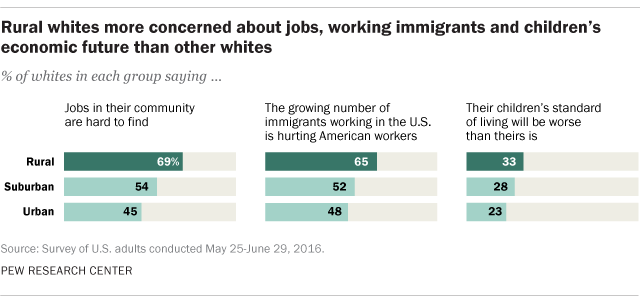In rural parts of America, it wasn’t just white men who flocked to the polls on Election Day to vote for Donald Trump. Rural white women were right there in the voting lines with them.
The NBC News national exit poll documented how Trump and his populist message disproportionately appealed to both white men and women living in rural America. A recent survey by Pew Research Center, conducted this spring in association with the Markle Foundation, illustrates the depth of their financial frustrations with the status quo on some key economic measures – anxieties that are more deeply felt by rural whites than by whites living in the nation’s cities or suburbs.
 Overall, Trump won small towns and rural America easily on Nov. 8, claiming 62% of the votes while Democratic candidate Hillary Clinton received 34%. By contrast, Trump won a more modest 50% to 45% victory in the suburbs while losing handily to Clinton in urban areas 59% to 35%.
Overall, Trump won small towns and rural America easily on Nov. 8, claiming 62% of the votes while Democratic candidate Hillary Clinton received 34%. By contrast, Trump won a more modest 50% to 45% victory in the suburbs while losing handily to Clinton in urban areas 59% to 35%.
The gender gap was a key part of the narrative this election season. Overall, 54% of all women voters said they voted for Clinton, while about the same proportion of men supported Trump (53%), the NBC News exit poll found. But among whites, the story was very different – particularly among men and women living in rural areas or small towns.
Trump won comfortable majorities of both rural white men and women, according to the exit poll. While Trump held a 10-percentage-point advantage over Clinton among white women nationally (53% to 43%), his victory margin nearly triples to 28 points among rural white women (62% to 34%). Trump led Clinton by 32 points among all white men nationally (63% to 31%), but he beat the Democrat by 48 points among white men living in rural areas (72% to 24%).
The Pew Research Center survey, conducted May 25 to June 29, 2016, with a nationally representative sample of 5,006 adults, suggests that the broad economic concerns of rural white Americans align to a striking degree with several key issues that were among the cornerstones of the Trump campaign: jobs, immigrants and fears about an eroding standard of living. Moreover, these anxieties are more deeply felt among rural whites than among whites in the cities or suburbs. Among the issues:
- Where are the jobs? Not here. Roughly seven-in-ten rural white residents (69%) say jobs in their communities are hard to find. By contrast, 45% of whites living in urban areas and 54% of those living in the suburbs say it’s difficult to find work where they live, the Pew Research Center survey found. About three-quarters (74%) of rural white women and 64% of rural white men say jobs are scarce. In each case, those shares are significantly higher than those of urban white women and men (50% and 40%, respectively) who say it’s hard to find work in their areas, as well as those of their suburban counterparts (56% of suburban white women and 50% of suburban white men).
- Concerns about working immigrants. Most rural white residents (65%) say American workers are being hurt by the growing number of immigrants working in the U.S., compared with about half of urban (48%) and suburban (52%) white residents. Among whites, both rural men and women (65% for both groups) are more likely than urban men (46%) and women (49%) or their suburban counterparts (55% and 49%, respectively) to say immigration has a negative impact on workers.
- Pessimism about their children’s financial future. A core tenet of the American dream is the belief that each generation will be better off than the last. Overall, 46% of Americans say they expect their children will be better off than they are, while about a quarter (24%) say their children will be worse off and 19% say their children will enjoy about the same standard of living. But rural white residents are less certain about their children’s future than whites living in cities or the suburbs. A third of rural whites – but only about a quarter of white city dwellers (23%) or suburbanites (28%) – believe their children will have a worse standard of living when they are their age. Rural white men in particular hold this bleak view; among all rural whites, 40% of men but only 27% of women predict a worse standard of living for their children. By contrast and regardless of their gender, about a quarter (23%) of urban whites and roughly three-in-ten suburban whites (28%) are similarly pessimistic about their children’s future, the Center’s survey found.
On other jobs-related issues, there are additional prominent gender gaps among white adults living in rural America. For example, rural white women are far more likely than men to say the federal government has at least some responsibility to ensure that workers have the right training and skills to be successful (67% of women say this compared with 53% of men). In fact, about a quarter of rural white men (23%) say the federal government has no responsibility for worker training and education, a view shared by only 6% of rural white women.
On other measures that did not feature prominently in Trump’s campaign, rural white men stand apart from rural women as well as from white urban and suburban residents. While substantial majorities of men and women see some role for colleges and universities in providing necessary skills and education, rural white men are far less likely than rural white women (71% vs. 92%) to say this. Rural white men are also significantly less likely than urban or suburban white men (82% and 84%, respectively) to see a role for institutions of higher education.



